See also
| This disambiguation page lists articles associated with the title Béarn. If an internal link led you here, you may wish to change the link to point directly to the intended article. |
Béarn can refer to:
| This disambiguation page lists articles associated with the title Béarn. If an internal link led you here, you may wish to change the link to point directly to the intended article. |

Pyrénées-Atlantiques is a department in the southwest corner of France and of the region of Nouvelle-Aquitaine. It takes its name from the Pyrenees mountains and the Atlantic Ocean. It covers the French Basque Country and the Béarn.

Lower Navarre is a traditional region of the present-day French département of Pyrénées-Atlantiques. It corresponds to the northernmost merindad of the Kingdom of Navarre during the Middle Ages. After the Spanish conquest of Iberian Navarre (1512–24), this merindad was restored to the rule of the native king, Henry II. Its capitals were Saint-Jean-Pied-de-Port and Saint-Palais. In the extreme north there was the little sovereign Principality of Bidache, with an area of 1,284 km2 (496 sq mi) and a decreasing population of 44,450, 25,356.

Soule is a former viscounty and French province and part of the present day Pyrénées-Atlantiques département. It is divided into two cantons of the arrondissement (district) of Oloron-Sainte-Marie, and a part of the canton of Saint Palais.

Labourd is a former French province and part of the present-day Pyrénées Atlantiques département. It is one of the traditional Basque provinces, and identified as one of the territorial component parts of the Basque Country by many, especially by the Basque nationalists.
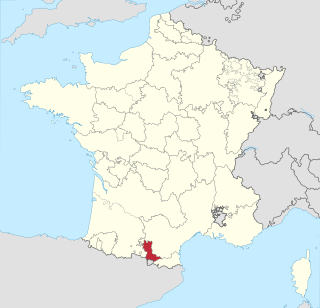
The County of Foix was an independent medieval fief in southern France, and later a province of France, whose territory corresponded roughly the eastern part of the modern département of Ariège.
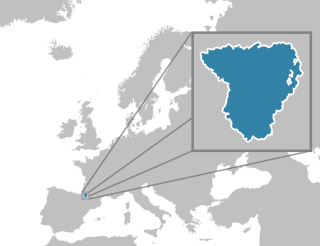
Béarn is one of the traditional provinces of France, located in the Pyrenees mountains and in the plain at their feet, in southwest France. Along with the three Basque provinces of Soule, Lower Navarre, and Labourd, the principality of Bidache, as well as small parts of Gascony, it forms in the southwest the current département of Pyrénées-Atlantiques (64). The capitals of Béarn were Beneharnum, Morlaàs, Orthez, and then Pau.
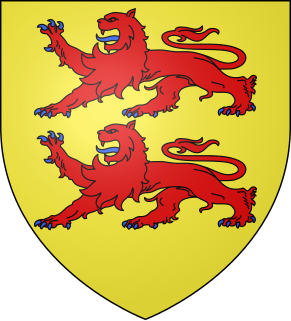
Bigorre is a region in southwest France, historically an independent county and later a French province, located in the upper watershed of the Adour, on the northern slopes of the Pyrenees, part of the larger region known as Gascony. Today Bigorre comprises the centre and west of the département of Hautes-Pyrénées, with two small exclaves in the neighbouring Pyrénées Atlantiques. Its inhabitants are called Bigourdans.
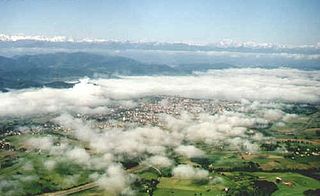
Nébouzan was a small province of France located in the foothills of the Pyrenees mountains, in the southwest of France. It was not a contiguous province, but it was made up of several detached territories, approximately half of them around the town of Saint-Gaudens in the south of the present-day département of Haute-Garonne, and the other half around the town of Lannemezan in the east of the present-day département of Hautes-Pyrénées. The capital of Nébouzan was Saint-Gaudens.

Gaston Fébus [also spelt Phoebus] was the eleventh count of Foix and viscount of Béarn from 1343 until his death.

The viscounts of Béarn were the rulers of the viscounty of Béarn, located in the Pyrenees mountains and in the plain at their feet, in southwest France. Along with the three Basque provinces of Soule, Lower Navarre, and Labourd, as well as small parts of Gascony, it forms the current département of Pyrénées-Atlantiques (64).

Centule V, called the Young, was the Viscount of Béarn from 1058 to his death. Centule increased the autonomy of the viscounts of Béarn and distanced them from the dukes of Aquitaine, to whom they owed theoretical vassalage. Centule was also Count of Bigorre jure uxoris as Centule I.
Talesa, Talèse, Talèze, or Ataresa was an Aragonese noblewoman and relative of the royal Jiménez dynasty. She was the daughter of Sancho Ramírez, Count of Ribagorza, natural brother of King Sancho Ramírez of Aragon and Navarre. She married Gaston IV of Béarn and acted as regent of the viscounty of Béarn during his absences on Crusade in 1096-1101, and after his death for their son in 1131-1134.
The Fors de Bearn, or fueros of Béarn, are a series of legal texts compiled over centuries in the Viscounty of Béarn. Together they formed the constitution of Béarn at the time of their first known complete version in the fifteenth century.
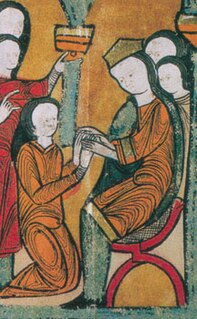
Mary was the daughter, sister, wife, and mother of various Viscounts of Béarn, Gabardan, and Brulhois. Briefly, from 1170 to 1171, she ruled Béarn as Viscountess in her own right.

The Viscounty, later Principality, of Béarn was a medieval lordship in the far south of France, part of the Duchy of Gascony from the late ninth century. In 1347 the viscount refused to acknowledge the suzerainty of the French king and declared Béarn an independent principality. It later entered a personal union with the Kingdom of Navarre in 1479 and with France in 1589. In 1620 the prince formally incorporated Béarn as a province of France.

A psalterium, or tambourin à cordes, is an ancient stringed musical instrument, the name of which is synonymous with the psaltery. In specific usage, this name denotes a form of long psaltery that is tuned to provide drone chords. Sometimes called a "string drum", though not to be confused with a friction drum also called a "string drum", it is usually used as rhythm accompaniment with a form of tabor pipe. It is also known as tambourin de Béarn or Tambourin de Gascogne in French, ttun-ttun[cunˈcun] in Basque, salmo in Spanish, and chicotén in Aragonese.

Aubous is a commune in the Pyrénées-Atlantiques department in the Nouvelle-Aquitaine region of south-western France.

Araujuzon is a commune in the Pyrénées-Atlantiques department in the Nouvelle-Aquitaine region of southwestern France.

The xirula is a small three holed woodwind instrument or flute usually made of wood akin to the Basque txistu or three-hole pipe, but more high pitched and strident, tuned to D/G and an octave higher than the silbote. The sound that flows from the flute has often been perceived as a metaphor for the tweet cadences of bird songs. Some scholars point out that flutes found in the Caverns of Isturitz and Oxozelaia going back to a period spanning 35,000 to 10,000 years ago bear witness to the early presence of the instrument's forerunner in the region, while this view has been disputed.
The crown lands, crown estate, royal domain or domaine royal of France were the lands, fiefs and rights directly possessed by the kings of France. While the term eventually came to refer to a territorial unit, the royal domain originally referred to the network of "castles, villages and estates, forests, towns, religious houses and bishoprics, and the rights of justice, tolls and taxes" effectively held by the king or under his domination. In terms of territory, before the reign of Henry IV, the domaine royal did not encompass the entirety of the territory of the kingdom of France and for much of the Middle Ages significant portions of the kingdom were the direct possessions of other feudal lords.